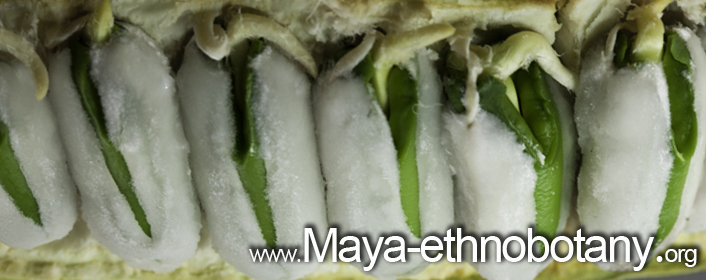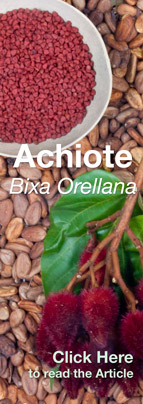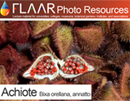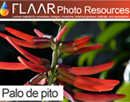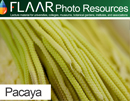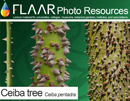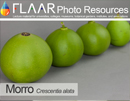When time and funding permit, each flower (each plant species) will have its own page, and its own PDF, and eventually its own PPT so that professors and students have plenty of material on Guatemala (and Honduras, etc) to study.
Heliconia adflexa, Coban, Guatemala, Hotel Monja Blanca, FLAAR, by Nicholas Hellmuth
This space is for flowers
we have recently found and photographed.
|
| Share
|
| Cassia grandis flower photos edible food crop stimulant libido cacao flavoring |
|
Two species of Cassia in Guatemala Cassia grandis is native, and has pink flowers. Cassia fistula is from Asia, and has yellow flowers. These trees flowers from January, February, March, April, May.  Cassia grandis or carao flower cacao flavor. Cassia grandis or carao flower cacao flavor.The Cassia grandis is known as bucut, carague, carao, mucut, or Pink Shower Tree. This is not cañafístola or cañafístula. That is Cassia fistula and is from Asia. The pre-Columbian species is Cassia grandis. However because the seed pod is similar in both species, the native tree in Mesoamerica is also called cañafístola or cañafístula. Uses of Cassia grandis, bucut The informative book by OFI-CATIE gives a general statement on use of Cassia grandis.  Cassia grandis or carao flower cacao flavor, Río los Esclavos, Santa Rosa Cassia grandis or carao flower cacao flavor, Río los Esclavos, Santa RosaEn Centroamérica, especialmente Costa Rica, la pulpa azucarada color café que rodea las semillas se usa como substituto del chocolate y los mayas lo usaban para endulzar bebidas. La pulpa es dulce pero maloliente. En Nicaragua se cuece con leche y en Choluteca, Honduras y en El Salvador se hacen frescos. Sin embargo, parece tener propiedades laxantes, depurativas y estimulantes, por lo que su uso es limitado. En Guatemala se venden en los mercados en Petén para medicina casera. También se venden en los mercados y tiendas de El Salvador por su pulpa comestible, que generalmente se prepara en bebidas. (Cordero and Boshier 2003: 439.  Cassia grandis or carao flower cacao flavor Cassia grandis or carao flower cacao flavorAlso used as a living fence. In general, documentation of the use of such trees is inadequate. Generally everyone quotes on source. And 90% of the web sites simply copy-and-paste and do not cite where they are taking the info from. But even without scholarly citations it still helps to have information, such as the following:  Cassia grandis or carao flower cacao flavor, Río los Esclavos, Santa Rosa Cassia grandis or carao flower cacao flavor, Río los Esclavos, Santa RosaIron Magazine recently reported that: “It's known as Cassia Grandis and has been an effective natural remedy for anaemia. But it also has an interesting side effect in many men. It reportedly spurs spontaneous libido. Could this be due to a lowering of SHBG? At this point, it would only be speculative to say. One would think that something that cured anaemia would be high in iron but tests on Carao extract reveal almost no iron. This one is a big question mark. It could be nothing more than the impoverished people were anaemic before taking it and once cured, felt completely revitalized, yet among athletes who have tried it, the consensus is that it definitely improves endurance.” (www.belize.com/articles/flora/cassia-grandis-bukut-tree.html#ixzz1xAQfSVD3)  Cassia grandis or carao flower cacao flavor. Cassia grandis or carao flower cacao flavor.Location of Cassia grandis in Guatemala. Cassia grandis can be seen at Parque Nacional Tikal, near the aguada next to the sculpture museum. There is a nice sign at the base of the tree clearly identifying it.  Cassia grandis or carao flower cacao flavor. Cassia grandis or carao flower cacao flavor.Botanical books indicate that this tree grows in most of the departamentos of Guatemala below 1000 meters elevation, so more than half the country. We found it in a garden near the Rio de los Esclavos, one hour drive from Guatemala City. Blooming in mid-March.  Cassia grandis or carao flower cacao flavor. Cassia grandis or carao flower cacao flavor. Cassia grandis or carao flower cacao flavor. Cassia grandis or carao flower cacao flavor.Introductory Bibliography on Cassia grandis
Faculty of Chemical Sciences and Pharmacy, University of San Carlos, Guatemala. Bibliography: Web siteswww.belize.com/articles/flora/cassia-grandis-bukut-tree.html posted March 12, 2013. |
Parque Nacional Yaxha, Nakum and Naranjo
Carnivorous Plants
Plants of Municipio de Livingston, Izabal
- Acrostichum danaeifolium, giant leather ferns
- Bellucia Pentamera
- Bibliography on Grias cauliflora
- Bibliography on Licania platypus
- Bibliography on Mangle negro (Avicennia germinans) L.
- Bibliography on Montriacardia arborescens
- Bibliography on Typha domingensis and Thypha latifolia
- Conocarpus erectus, white mangrove
- Edible Wetlands Plants, Hotel Tortugal
- Heliconia latispatha
- Heliconia wagneriana
- Manicaria saccifera Confra palm
- Neotropical trees of Guatemala need protection
- Nymphoides indica, waterlily flowers
- Pachira aquatica, zapoton
- Bibliography on Pithecellobium Mart., Neotropical trees of Mesoamerica
Ecosystems, Wetlands Aquatic Plants
Smartphone Camera Reviews
Bushes and small trees
Fungi and Lichens
Orchids
- Bibliography Bletia purpurea, aquatic orchid
- Bibliography, Epidendrum radicans
- Bibliography on Habenaria Orchids from Yaxha
- Bibliography, Lycaste virginalis var. alba.
- Bibliography, Macroclinium bicolor
- Bibliography, Prosthechea cochleata
- Bibliography Sobralia macrantha, Lirio de San Juan
- Bibliography, Sobralia xantholeuca
- Bibliography on Terrestrial shade orchids from Guatemala
- Bibliography on Terrestrial sunny orchids from Guatemala
Botanical Terms
Maya and Aztec flavorings for cacao, cocoa, chocolate
- Achiote, Bixa orellana
- Bibliography on Achiote, Bixa orellana
- Bibliography on Esquisúchil, Bourreria huanita
- Bourreria huanita
- Cassia grandis, bucut
- Chile Chocolate
- Chile Chocolate (Capsicum annuum var accuminatum)
- Chiranthodendron pentadactylon
- Cymbopetalum penduliflorum
- Guazuma ulmifolia
- Haematoxylum brasiletto
- Piper auritum, hoja santa
- Piper species
- Quararibea funebris
- Sterculia apetala, castaño
- Tagetes sp., Marigold
- Talauma, a variant of Magnolia
- Vanilla orchid
- Virola and nutmeg
Cacao, cocoa, chocolate
Consulting cacao & Theobroma species
Tobacco Ingredients of Aztec & Maya
Trees of Mesoamerica
- Bibliography on Acacia dolichostachya, Wild tamarind
- Bibliography, Bellucia costaricensis
- Bibliography, Bucida buceras
- Bibliography on Coccoloba belizensis Standl.
- Bibliography on Cojoba sp. and Cojoba arborea
- Bibliography, Ficus.
- Bibliography on Haematoxylum campechianum and H. brasiletto
- Bibliography on Hibiscus pernambucensis
- Bibliography on Ipomea murucoides
- Bibliography on Lacmellea standleyi, lechemiel
- Bibliography on Leucaena leucocephala
- Bibliography on mangle rojo (Rhizophora mangle)
- Bibliography on Manzanillo, Alseis yucatanensis Standl.
- Bibliography on Matilisguate, Tabebuia rosea
- Mangrove swamp Trees
- Bibliography on Ruagea insignis
- Bibliography on Pterocarpus officinalis
Bombacaceae, Bombacoideae
Tropical Fruits of the Maya
- Avocado Hass
- Bibliography on Coloc, Talisia floresii
- Bibliography, Dichogamy of avocado species
- Bibliography on Guayo, Talisia olivaeformis
- Bibliography on Laetia thamnia, Bakelac
- Bibliography on Maracuyá, Passiflora quadrangularis L.
- Bibliography on Punica granatum L., Granada
- Cashew
- Cuajilote, Parmentiera aculeata
- Granada
- Guanabas and Annonas
- Guava, Guayaba, Psidium guajava L
- Introduction to Papaya
- Nance a fruit of prehispanic Guatemala
- Passion flowers and fruits
- Passion flower, giant fruit
- Talisia floresii, Sapindaceae
- Carica Papaya Bibliography
Tropical Nuts
Spices, condiments, food coloring
Medicinal Plants
- Aristolochia, The largest flower in Guatemala, Bibliography
- Asclepias curassavica, bibliography
- Bibliography on Ciricote, Cordia dodecandra
- Bibliography on Contrahierba, Dorstenia contrajerva
- Bibliography on Falso hibisco, Malvaviscus arboreus
- Bibliography on Huele de noche, Cestrum nocturnum
- Bibliography on Lirio araña, Hymenocallis littoralis
- Bibliography on Roble Prieto, Ehretia tinifolia
- Bibliography, Tithonia diversifolia
- Canak
- Calliandra general info
- Guava, Guayaba
- Magnolia and Taluma
- Mayan medicinal plants
- Piper
- Tecomasuche, Coclospermum vitifolium
- Bibliography on Sufricay, Malmea depressa
- Bibliography on Wigandia urens
Underutilized edible plants
Edible Plants of the Mayan World
- Acacia, subin, bullhorn acacia
- Bibliography, Annona muricata
- Bibliography, Annona purpurea
- Bibliography, Annona reticulata
- Bibliography on Chipilín, Crotalaria longirostrata
- Bibliography on Chirimoya, Annona squamosa
- Bernoullia flammea
- Canna indica, tamale wrap
- Cuchamper, Gonolobus
- Guava, Guayaba
- Bibliography, Gonobolus sp.
- Bibliography, Parmentiera aculeata
- Pacaya palm Chamaedorea tepejilote
- Split leaf philodendron, Monstera deliciosa
Plants and trees used to produce incense
Utilitarian Plants
- Bibliography, Acacia farnesiana
- Bibliography on Aechmea bromeliifolia
- Bibliography on Agave americana
- Bibliography, native Agave species from Guatemala
- Bibliography on Anthurium crassinervium (Jacq.) Schott
- Bibliography on Balsa, Ochroma pyramidale
- Bibliography on Bamboo, Guadua longifolia (E.Fourn) R.W.Pohl
- Bibliography, Crescentia alata
- Bibliography, Crescentia cujete
- Bibliography on Hule, Castilla elastica
- Blepharidium guatemalense, irayol blanco
- Crescentia alata, Crescentia cujete
- Tecomasuche, Coclospermum vitifolium
- Bibliography on Coxte, Colubrina arborescens
- Bibliography on Madre cacao, Gliricidia sepium
- Bibliography on Tillandsia usneoides
